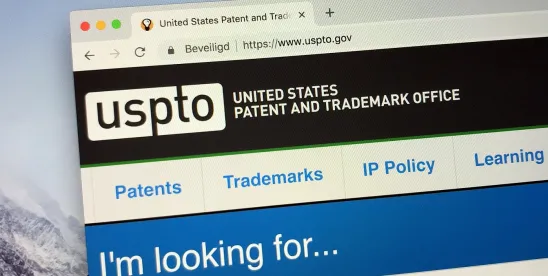In February, we posted about the USPTO’s Inventorship Guidance for AI-assisted Inventions, 89 Fed. Reg. 10043 (Feb. 13, 2024), and how that guidance might affect a retailer in New USPTO AI-Assisted Invention Guidance Will Affect Retailers and Consumer Goods Companies.
In mid-July, the USPTO released another set of AI guidance, focusing on subject matter eligibility: 2024 Guidance Update on Patent Subject Matter Eligibility, Including on Artificial Intelligence, 89 Fed. Reg. 58128 (Jul. 17, 2024). Effective as of July 17, 2024, the new guidance should be viewed in concert with the previous guidance. The new guidance covers two primary bases: 1) addressing patent eligibility of AI-related inventions and 2) further explaining Step 2A of the USPTO’s eligibility analysis. Also released with the guidance are three examples, following the format of the USPTO’s previously-released subject matter eligibility examples and providing an exemplary application of the guidance.
The first, and perhaps most critical, takeaway from the new guidance is that AI-related inventions do not get any special treatment. The guidance notes that, whether an invention is developed with AI is not a consideration in the eligibility analysis, referencing prior guidance on AI-assisted inventions. Critically, the USPTO reinforces that “AI-assisted inventions are not categorically unpatentable.”
AI-related inventions accordingly will be examined under the existing patent eligibility framework, which consists of two main steps. Step 1 is an assessment of whether the invention for which patent protection is sought falls within a statutory category (i.e., process, machine, manufacture or composition of matter). Step 2 applies the Supreme Court’s Alice/Mayo analysis to identify whether the patent claims are directed to a judicial exception and then to evaluate whether additional elements in the claim provide an inventive concept. Step 2 has two sub-steps: Step 2A (that includes Prong One and Prong Two) and Step 2B.
The new guidance shows the application of the eligibility framework to AI-related inventions, noting that stakeholder feedback to prior guidance identified two areas of “particular concern” regarding patentability of AI-related inventions: “(1) the evaluation of whether a claim recites an abstract idea in Step 2A, Prong One; and (2) the evaluation of the improvements consideration in Step 2A, Prong Two.” The guidance admits that Step 2A, Prong One may be “challenging for AI inventions.” This is likely because “it is common for claims to AI inventions to involve abstract ideas.” The guidance directs USPTO personnel to distinguish “between a claim that ‘recites’ an abstract idea (and thus requires further eligibility analysis) and one that merely involves, or is based on, an abstract idea.”
The guidance walks through Step 2A, Prong One (whether a claim recites an abstract idea), providing hypothetical examples as well as examples from recent case law. Next, it goes through Step 2A, Prong Two in a similar manner, relying primarily on case law examples and discussion of AI inventions and how such fit into this step.
As mentioned above, the guidance includes three new examples, numbered 47-49 (46 examples pertaining to other technologies in the context of the eligibility framework were previously issued). First, Example 47 applies the eligibility analysis to claims related to “the use of an artificial neural network to identify or detect anomalies.” Next, Example 48 applies the eligibility analysis to claims reciting “AI-based methods of analyzing speech signals and separating desired speech from extraneous or background speech.” Finally, Example 49 applies the eligibility analysis to claims reciting “an AI model that is designed to assist in personalizing medical treatment to the individual characteristics of a particular patient.” While narrowly focused on certain AI-related technologies, Examples 47-49 demonstrate application of the framework in different scenarios, and are instructive at least from that aspect.
From the retail and consumer products perspective, Examples 47 and 48 are worth reviewing more closely, since the scenarios and analysis can be extended to cover AI systems potentially used in the retail space. Example 48 covers “methods of analyzing speech signals and separating desired speech from extraneous or background speech.” This may be similar to AI-based chatbots or customer service systems used in retail. Similarly, Example 47 covers “the use of an artificial neural network to identify or detect anomalies.” This could be extended to ordering systems or warehouse tracking systems that may use similar artificial neural networks. So, even though the examples do not specifically refer to particular retail related systems or networks, they may provide insight into how retail-based inventors could best craft patent claims to cover AI-related systems that may be used in the retail space.
This guidance is a crucial step from the USPTO to attempt to clarify how its eligibility framework applies to AI-related inventions.
For retail clients seeking patent protection on AI-related inventions, it is critical to understand how the eligibility framework is applied by the USPTO, as well as where to focus arguments in response to rejections from patent examiners. Ensuring that a patent specification provides sufficient technical details, including the areas of improvement offered by the invention, is important because such detail may be needed to reinforce the claims through amendments to overcome a subject matter eligibility rejection. Further, establishing a dialogue with the examiner is important, as many examiners will provide suggestions on claim amendments to overcome an eligibility rejection.




 />i
/>i

